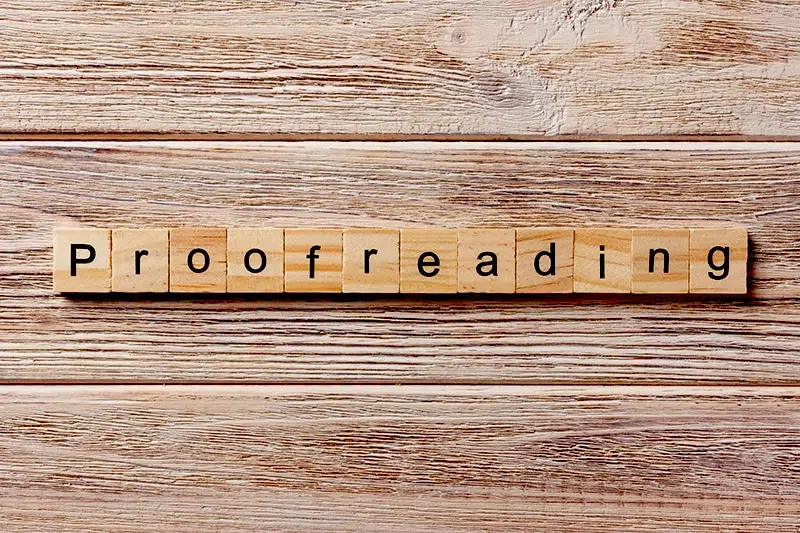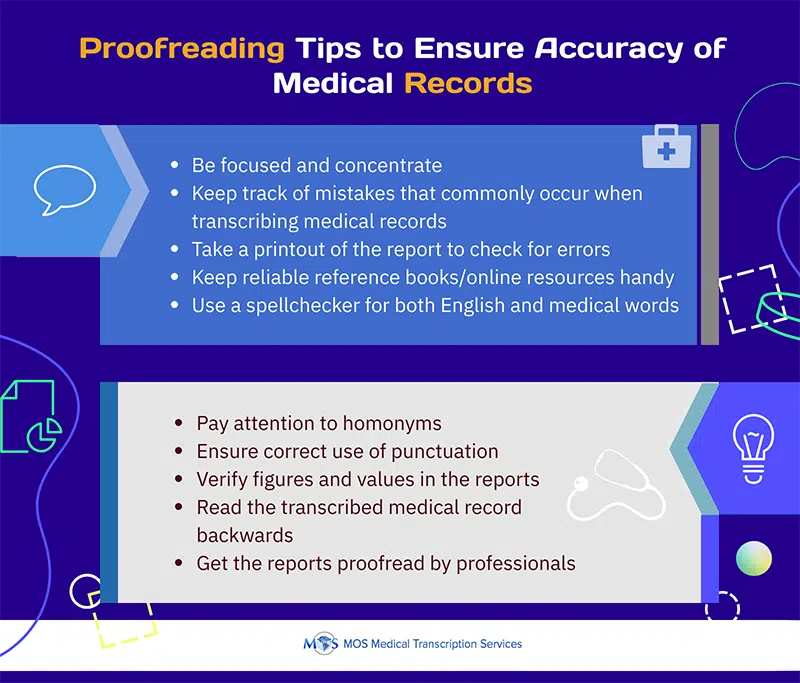
Table of Contents
To maintain high quality, compliant medical documentation, communicate efficiently with other healthcare providers and deliver proper care, physicians need to convert their dictated notes into accurate medical records. medical transcription services play a critical role in this context, transforming physician-dictated audio content into precise, written notes for integration into electronic health records (EHRs). How do medical transcriptionists ensure high accuracy and clarity in transcribed documents? They do so by carefully proofreading the medical documents before they are returned to the physician.
Before we discuss proofreading strategies in medical transcription, let’s take a look at common mistakes found in medical documents.
Common Medical Transcription Errors that Proofreading can Identify
Mistakes in medical records can harm patients, leading to adverse events or even death. Inaccuracies may prompt incorrect decisions or treatments by physicians, compromising patient safety. Common errors found in medical records are:
- Omission of dictated words due to fast typing
- Choosing the wrong words; due to audio issues, words may be selected wrongly.
- Misspelled words
- Typographical errors that may occur due to fast typing.
- Grammatical errors
- Punctuation errors when commas, semicolons, hyphens, dashes or quotation marks are used incorrectly, and this may change the meaning of sentences.
- Homonyms are sound-alike words and the correct word should be used to get the appropriate meaning that is consistent with the doctor’s dictation. Errors related to homonyms may occur in both English language and medical terminology.
Proofreading transcribed medical documents helps identify such errors, inconsistencies, and omissions. Now, let’s take a look at some key techniques that professionals use to enhance the medical transcript proofreading process:
Key Proofreading Strategies for Medical Transcription
- Use a printout: Proofreading on the screen can sometimes be a challenge. Using a printout of the report is often much easier than reading on the screen.
- Concentrate: To spot errors effectively, experts maintain a high level of concentration. They proofread medical records in a distraction-free environment by putting away their phone, turning off the television, and staying clear of any other devices that might cause interruptions.
- Read aloud: Reading the transcribed document aloud can help identify errors that may be overlooked when reading silently. Experienced transcriptionists focus on sentence structure, grammar, punctuation, and the overall flow of the text. Reading aloud can also help identify missing or incorrect words.
- Read it backwards: Usually, when we create medical records, we tend to ignore or become blind to our own mistakes. This is because the brain automatically corrects errors, making it challenging for individuals to spot them. To overcome this tendency, professional transcriptions read the medical record backward. This unconventional approach may help identify mistakes that might be missed during a standard, forward reading.
- Use reference materials: Teams in medical transcription companies will keep medical reference materials handy, such as medical dictionaries, drug references, and style guides. These resources can help verify medical terms, drug names, abbreviations, and formatting conventions. They cross-reference the transcribed text with these resources to ensure accuracy and consistency.
- Keep track of all medical mistakes: Medical transcriptionists also keep track of all the mistakes that commonly occur in their work. Categorizing and reviewing these errors helps avoid repeating them.
- Check spellings and homonyms: Double-checking the spelling of medical terms, drug names, and specialized vocabulary is an important proofreading strategy. Many medical terms can sound similar but have different spellings and meanings. Reliable transcriptionists pay special attention to homonyms (words that sound alike but have different meanings) and ensure that the correct word is used in context. For e.g., consider these sentences with words ‘bare’ and ‘bear’:
- The patient’s skin was left bare during the examination.
- The patient has difficulty trying to bear weight on the injured leg.
Misinterpreting or misspelling homonyms can lead to significant errors in medical transcripts. While AI-powered tools can correct basic language, grammar, style, spelling errors, and even common homonym errors, they might not work if the context is ambiguous. That’s where the human proofreading skills become significant.
- Verify numbers and measurements: Experts pay special attention to numbers, measurements, and data in the transcribed document. Stating the correct figure and value in medical reports is critical. A minor variation in figures like the dosage of medicine or lab reports value can impact patient safety, and even be life-threatening. By checking for accuracy, decimal placement, and consistency, they ensure that units of measurement are correctly transcribed and match the appropriate medical context.
- Check punctuation and formatting: Professionals will review punctuation, capitalization, and formatting. They will ensure that medical abbreviations and acronyms are correctly punctuated and aligned with established guidelines, and parentheses, brackets, commas, and hyphens provide clarity and accuracy.
- Get feedback: Finally, medical transcriptionists will collaborate with others in their team and supervisors to get feedback and second opinions. A fresh set of eyes can often catch errors that may have been overlooked during self-proofreading.
Check Out Our Infographic:

Proofreading is a critical step in medical transcription that ensures accuracy and enhances patient safety. By employing these techniques, experienced transcriptionists improve the quality and reliability of transcribed medical documents. That’s why most medical practices choose to outsource their documentation tasks to a reliable US based medical transcription company. Leading companies have stringent quality checks in place to ensure accurate transcripts that meet specific instructions or guidelines provided by the healthcare professionals or organizations. Their team also stays updated with the latest medical terminology, guidelines, and industry best practices, which enhances their knowledge and skills in medical transcription and improves the quality of the documentation.


